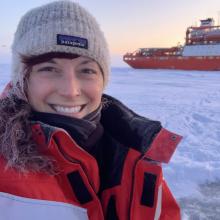In the Same Boat
In fall 2019, Jessie Creamean found herself floating on an ice floe well north of the Arctic Circle, where occupational hazards range from polar bears and near total darkness to windchills approaching 50 degrees below zero.
Working to collect air and ice samples, the Colorado State University researcher was not alone. Creamean was part of what will ultimately become a cohort of 300 researchers from 70 institutions in nearly 20 countries, all taking shifts aboard a German icebreaker that was intentionally moored in Arctic ice last September and left to drift through one of the world’s least explored regions.
Organized by Germany’s Alfred Wegener Institute, the yearlong Multidisciplinary Drifting Observatory for the Study of Arctic Climate (Mosaic) expedition has literally put the world’s scientific community in the same boat.
Surrounded by ice, and traversing the Arctic Circle at a rate of about five miles a day, the RV Polarstern is equipped with a broad range of scientific instruments—and several crew members whose official job description is “polar bear guard.” Divided into teams, the researchers venture onto the ice to gather samples that, organizers hope, will bring together a better understanding of how climate change is affecting the Arctic—and by definition, the entire world. (Follow their progress here.)
For Creamean, whose own research centers around cloud formation, the Arctic is of vital importance.
“Clouds act like thermostats over sea ice,” she says. “Depending on their properties, they can reflect sunlight or trap heat, and that in turn can help facilitate












